Synthetic biology toolbox for nitrogen-fixing soil microbes.
Synthetic biology toolbox for nitrogen-fixing soil microbes.
Autoria: VENKATARAMAN, M.; YN?IGEZ-GUTIERREZ, A.; INFANTE, V.; MACINTYRE, A.; FERNANDES JUNIOR, P. I.; ANÉ, J.-M.; PFLEGER, B.
Resumo: The soil environment adjacent to plant roots, termed the rhizosphere, is home to a wide variety of microorganisms that can significantly affect the physiology of nearby plants. Microbes in the rhizosphere can provide nutrients, secrete signaling compounds, and inhibit pathogens. These processes could be manipulated with synthetic biology to enhance the agricultural performance of crops grown for food, energy, or environmental remediation, if methods can be implemented in these nonmodel microbes. A common first step for domesticating nonmodel organisms is the development of a set of genetic engineering tools, termed a synthetic biology toolbox. A toolbox comprises transformation protocols, replicating vectors, genome engineering (e.g., CRISPR/Cas9), constitutive and inducible promoter systems, and other gene expression control elements. This work validated synthetic biology toolboxes in three nitrogen-fixing soil bacteria: Azotobacter vinelandii, Stutzerimonas stutzeri (Pseudomonas stutzeri), and a new isolate of Klebsiella variicola. All three organisms were amenable to transformation and reporter protein expression, with several functional inducible systems available for each organism. S. stutzeri and K. variicola showed more reliable plasmid-based expression, resulting in successful Cas9 recombineering to create scarless deletions and insertions. Using these tools, we generated mutants with inducible nitrogenase activity and introduced heterologous genes to produce resorcinol products with relevant biological activity in the rhizosphere.
Ano de publicação: 2023
Tipo de publicação: Artigo de periódico
Unidade: Embrapa Semiárido
Palavras-chave: Biologia sintética, CRISPR, Caixa de ferramentas, Cas9, Edição de genoma, Nitrogenase, Solo
Observações
1 - Por padrão são exibidas publicações dos últimos 20 anos. Para encontrar publicações mais antigas, configure o filtro ano de publicação, colocando o ano a partir do qual você deseja encontrar publicações. O filtro está na coluna da esquerda na busca acima.
2 - Para ler algumas publicações da Embrapa (apenas as que estão em formato ePub), é necessário ter, no celular ou computador, um desses softwares gratuitos. Sistemas Android: Google Play Livros; IOS: iBooks; Windows e Linux: software Calibre.
Acesse outras publicações
Acesse a Base de Dados da Pesquisa Agropecuária (BDPA) para consultar o acervo completo das bibliotecas da Embrapa.

